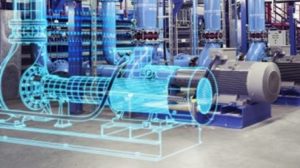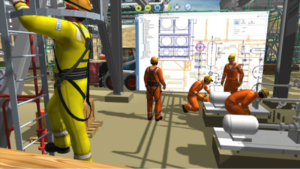Shipyard 4.0 Concept Features 3D Printing, Digital Twins, Advanced Technologies for Shipbuilding in Spain and Australia
 One of the many industries that is increasingly using 3D printing technology is shipbuilding: we’ve seen everything from a 3D printed class-approved propeller to a heightening focus on high-tech and IP implications for the maritime industry. Spanish state-owned Navantia is a leading technology company that designs and builds high-tech civil and military vessels, control and combat systems, and manufactures diesel engines and turbines as well.
One of the many industries that is increasingly using 3D printing technology is shipbuilding: we’ve seen everything from a 3D printed class-approved propeller to a heightening focus on high-tech and IP implications for the maritime industry. Spanish state-owned Navantia is a leading technology company that designs and builds high-tech civil and military vessels, control and combat systems, and manufactures diesel engines and turbines as well.
The company wants to leverage new technologies in order to improve industry performance, in what’s known as the Fourth Industrial Revolution. This is the collective term for the digital revolution that’s characterized by contemporary automation, data exchange, and manufacturing technologies, including 3D printing, and according to Forbes, “is the concept of blurring the real world with the technological world.”
In order to reduce business costs and increase productivity in line with Industry 4.0, Navantia has implemented the Shipyard 4.0 model, which will apply and optimize these technologies for applications in shipbuilding. The model has been implemented in Navantia Spain’s Ferrol shipyard in order to build next-generation F110 frigates for the Spanish Navy, and Navantia Australia will also be adopting Shipyard 4.0, though customizing it for the country’s specific conditions.
“Navantia is firmly committed to being a sustainable company in the naval, strategic and international industry, developing competitive naval programs,” said Pablo Lopez, Director of the Ferrol shipyard, in a translated quote. “For this we have developed a strategy called Shipyard 4.0, which is the application of the enabling technologies of the 4th industrial revolution in which we are immersed, in our production processes. The Shipyard 4.0 has clear objectives of cost reduction, deadlines and increase of quality in our products and processes, to achieve the competitive sustainability of the company.”
The Shipyard 4.0 model will enhance the outcomes of Navantia Australia’s SEA 5000 and Continuous Build Program by helping to develop a sustainable shipbuilding industry for the Navy, creating a new skilled workforce and modern facilities for both the shipyard and the supply chain, and setting up a modern ICT infrastructure that will support the digital twin (ship zero) of the shipyard, as well as for the ship. The digital twin concept will allow for new products and processes to be simulated and developed at virtual work stations.
Navantia is working in a very competitive environment to achieve solutions, by applying the 12 main enabling technologies that merge with shipbuilding to make up the Shipyard 4.0 model:
- Additive manufacturing
- Artificial intelligence
- Autonomous vehicles
- Big data and analytics
- Cybersecurity
- Health, safety, and environment
- New materials
- Robotic process automation
- Secure cloud
- Ubiquitous connectivity and the Internet of Things (IoT)
- Virtual and augmented reality
- Virtual modeling and simulation
Navantia’s R&D+ i line makes use of 3D printing technology, supported by the INNANOMAT research group of the University of Cádiz, and the company presented one of its AM projects this week as it works to transform to the Shipyard 4.0 model.
“At the end of last year we were able to see the first results, at the end of Navantia’s first R & D project in additive manufacturing, called 3DCABINS with the integrated printing of a 3D modular toilet and the installation on board of a 2-vessel Ventilation grilles printed with this technology,” Lopez explained in a translated quote.
Astillero #PuertoReal, #Cádiz@NavantiaOficial presenta la Fabricación Aditiva con impresoras 3D.
Las técnicas de Fabricación Aditiva permiten producir
piezas a partir de modelos tridimensionales en formato digital.https://t.co/WPfKYR92Tk pic.twitter.com/09rQfry5L8— Navantia Oficial (@NavantiaOficial) January 18, 2018
The 3DCABINS project was a success, as it allowed Navantia to manufacture two naval toilet prototypes at a much lower cost, with a nearly 50% weight reduction – an outcome that would not have been possible without 3D printing.
“This year we have started a second R & D + i project, ADIBUQUE, with which we seek to consolidate the use of this technology in our vessels,” Lopez said. “Now we must promote the implementation of collaborative R + D + i projects with our IIAA, in order to put our naval sector in its rightful place.”
 Potentially 3D printable parts will analyzed on a ship as part of this project, and large-scale 3D printing technology will be used to construct ship elements. Both the 3DCABINS and the ADIBUQUE projects have helped Navantia navigate a clear path to enhancing the company’s use of additive manufacturing, which shows its commitment to the Shipyard 4.0 model and the Fourth Industrial Revolution.
Potentially 3D printable parts will analyzed on a ship as part of this project, and large-scale 3D printing technology will be used to construct ship elements. Both the 3DCABINS and the ADIBUQUE projects have helped Navantia navigate a clear path to enhancing the company’s use of additive manufacturing, which shows its commitment to the Shipyard 4.0 model and the Fourth Industrial Revolution.
What do you think of this news? Let us know your thoughts! Join the discussion of this and other 3D printing topics at 3DPrintBoard.com or share your thoughts below.
[Images: Navantia]
Subscribe to Our Email Newsletter
Stay up-to-date on all the latest news from the 3D printing industry and receive information and offers from third party vendors.
You May Also Like
US Army Corps of Engineers Taps Lincoln Electric & Eaton for Largest 3D Printed US Civil Works Part
The Soo Locks sit on the US-Canadian border, enabling maritime travel between Lake Superior and Lake Huron, from which ships can reach the rest of the Great Lakes. Crafts carrying...
Construction 3D Printing CEO Reflects on Being Female in Construction
Natalie Wadley, CEO of ChangeMaker3D, could hear the words of her daughter sitting next to her resounding in her head. “Mum, MUM, you’ve won!” Wadley had just won the prestigious...
Blue Laser-powered M600 3D Printer Launched by Meltio
Founded in 2019 as a joint venture between Additec and Sicnova, metal 3D printer OEM Meltio develops and manufactures high-performance and easy-to-use metal 3D printing solutions that use its patented wire-laser metal...
3D Printed Storage Tanks Cut Material Costs by 25%
In a previous article, “Concrete Dreams: Let’s Print Money, Not Houses,” we discussed how the spotlight on 3D printing homes might be misplaced. Bollards, pedestrian bridges, and concrete tanks could...

































